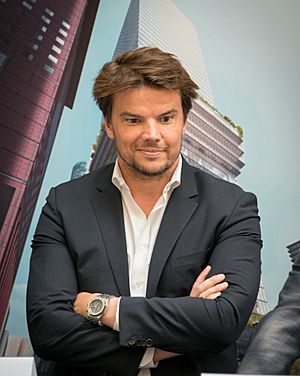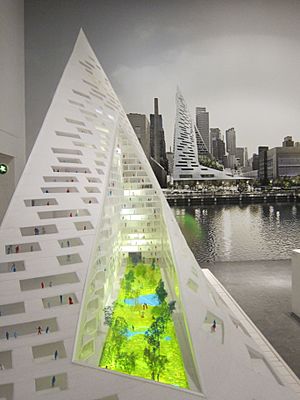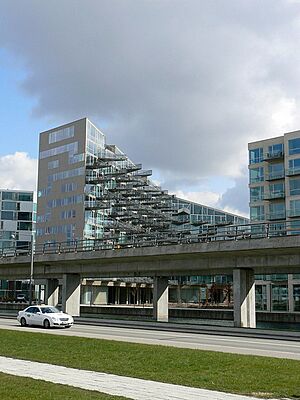Bjarke Ingels facts for kids
Quick facts for kids
Bjarke Ingels
|
|
|---|---|

Ingels in 2015
|
|
| Born |
Bjarke Bundgaard Ingels
2 October 1974 Copenhagen, Denmark
|
| Alma mater | Royal Danish Academy of Fine Arts, School of Architecture |
| Occupation | Architect |
| Practice | Bjarke Ingels Group |
Bjarke Ingels (born October 2, 1974) is a famous Danish architect. He is the founder and creative leader of a company called Bjarke Ingels Group (BIG). Ingels is known for designing buildings that are not only useful but also fun and exciting.
He became well-known in Denmark for designing unique apartment buildings like VM Houses and Mountain Dwellings. In 2006, he started BIG, which grew into a large company with many employees. Some of their famous projects include the 8 House apartment complex, the VIA 57 West building in New York, and the Google headquarters in California. They also designed the Superkilen park and the Amager Resource Center (ARC). This last building is a power plant that even has a ski slope and a climbing wall on its outside!
Since 2009, Ingels has won many architecture awards. He moved to New York City in 2012. There, his company won a competition to design flood protection for Manhattan after Hurricane Sandy. In 2011, The Wall Street Journal called him the "Innovator of the Year" for architecture. In 2016, Time named him one of the 100 "Most Influential People" in the world.
Contents
Early Life and Education
Bjarke Ingels was born in Copenhagen, Denmark, in 1974. His father was an engineer, and his mother was a dentist. When he was younger, he wanted to be a cartoonist. He started studying architecture in 1993 at the Royal Danish Academy of Fine Arts. He thought it would help him improve his drawing skills.
After a few years, he became very interested in architecture itself. He continued his studies in Barcelona, Spain, and finished his degree in Copenhagen in 1999. While still a student, he started his first design company and won his first competition. Besides his work at BIG, Ingels has also taught architecture at several top universities.
Amazing Buildings and Projects
Early Work and PLOT
From 1998 to 2001, Ingels worked for a famous architect named Rem Koolhaas in the Netherlands. In 2001, he returned to Copenhagen and started a design company called PLOT with a friend. Their designs were very creative and got a lot of attention. They even won a major award at the Venice Biennale of Architecture in 2004.
PLOT designed the Islands Brygge Harbour Bath in 2003. These are five outdoor swimming pools right on the Copenhagen waterfront, with special areas for kids. They also built the Maritime Youth House, a sailing club for young people.
One of PLOT's first big successes was the VM Houses in Copenhagen, finished in 2005. These are two apartment buildings shaped like the letters V and M when seen from above. The design focused on letting in lots of daylight and giving residents great views. Ingels lived in the M House until 2008.
In 2005, Ingels also completed the Helsingør Psychiatric Hospital. This hospital is shaped like a snowflake, and every room has a special view of either a lake or hills.
Starting BIG and New Ideas
After PLOT ended in 2005, Ingels started his own company, Bjarke Ingels Group (BIG), in January 2006. BIG quickly grew to have hundreds of employees.
One of BIG's first projects was the Mountain Dwellings, built next to the VM Houses. This building combines apartments with a large parking garage. The apartments are built on a sloping roof, creating an artificial "mountainside" where each apartment has a big terrace. The parking garage walls are covered in colorful aluminum panels. The outside of the building even has a huge picture of Mount Everest made from tiny holes in the metal! This building won several awards for its unique design.
Their third big housing project was the 8 House, finished in 2010. This is one of the largest private buildings ever built in Denmark. It's a 10-story building shaped like a figure 8, with apartments, shops, and offices. It has a special green roof that won an award. Ingels explained that the green roof helps the environment and makes the building look more interesting. The Huffington Post called 8 House one of the "10 Best Architecture Moments of 2001–2010."
In 2007, BIG was asked to design the Danish Maritime Museum in Helsingør. This museum is built underground, inside an old dry dock, near the famous Kronborg Castle. The design makes sure that even though it's underground, it still gets plenty of natural light. The inside of the museum is designed to feel like being on a ship's deck. The museum opened in 2013.
Global Reach and Big Projects
Ingels designed the Danish pavilion for the Expo 2010 in Shanghai, China. It was shaped like a giant loop with a spiral bike path. Visitors could ride bikes through the pavilion and see Danish culture. In the middle of a pool of water was the famous statue of The Little Mermaid.
BIG's projects started to become more international. They designed a hotel in Norway, a museum in Mexico City, and even a plan to turn an old oil area into an eco-friendly resort in Azerbaijan. This resort, called Zira Island, was designed to look like the seven mountains of Azerbaijan and was planned to be one of the world's largest eco-developments.
In 2011, BIG won a competition to design the roof of the Amagerforbrænding industrial building in Copenhagen. This building is a waste-to-energy plant, and its roof was designed to have ski slopes of different difficulty levels! This project is an example of what Ingels calls "hedonistic sustainability," meaning it's good for the environment but also fun.
In 2012, Ingels moved to New York City to work on a pyramid-shaped apartment building called West 57th Street. BIG opened a permanent office in New York. In 2014, Ingels' design for a flood protection system called the DryLine won a competition. This system helps protect Manhattan's shoreline from floods, like those caused by Hurricane Sandy.
BIG also designed the Lego House in Billund, Denmark, which opened in 2017. Ingels said that if BIG was created for just one building, it would be to design the house for Lego. The building looks like a village of interlocking blocks, just like Lego bricks! They also designed a big plan for the new Smithsonian Institution campus in Washington, D.C., which is a long-term project.
In 2015, Ingels started working with British designer Thomas Heatherwick on a new headquarters for Google in California. Later that year, BIG was chosen to design Two World Trade Center in New York City. This is one of the towers replacing the original Twin Towers.
Other Creative Work

In 2009, Ingels helped start a design group called KiBiSi. This group designs things like bicycles, furniture, and even aircraft. They designed the furniture for Ingels' Danish Pavilion at the Expo 2010.
Ingels has also written books about architecture. His first book, Yes Is More: An Archicomic on Architectural Evolution, was like a comic book. He thought this was the best way to tell stories about architecture. His second book, Hot to Cold: An Odyssey of Architectural Adaptation, looked at how people live in different climates around the world.
Ingels has given talks at famous events like TED. He often talks about "hedonistic sustainability," which means making things sustainable (good for the planet) in a way that is also enjoyable and fun.
He has also been featured in documentary films, including My Playground, which is about parkour, and Abstract: The Art of Design on Netflix.
Design Ideas
Ingels and BIG are known for their unique design ideas. They believe that architecture should connect all parts of society – social, cultural, economic, and political – into physical buildings. Ingels thinks that buildings should respond to the local environment and climate. This means using the weather and natural resources to make buildings better for people.
He often talks about "hedonistic sustainability." This idea means that being sustainable shouldn't feel like giving something up. Instead, it should be about gaining something exciting and attractive.
In 2014, Ingels released a video called Worldcraft. In it, he talked about creating architecture that turns "surreal dreams into inhabitable space." He was inspired by video games like Minecraft, where players can build their own worlds. Ingels believes that architecture should be like "Worldcraft," allowing us to turn our wildest ideas into real places. He says, "Architecture must become Worldcraft, the craft of making our world, where our knowledge and technology doesn't limit us but rather enables us to turn surreal dreams into inhabitable space. To turn fiction into fact."
Images for kids
See also
 In Spanish: Bjarke Ingels para niños
In Spanish: Bjarke Ingels para niños







